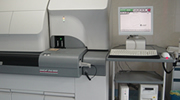Enhancing cultural self-confidence and carrying forward traditional medicine -- a visit to Zhejiang Hospital from the University of Leuven, Belgium
Hits: 3345 Time: 2021-09-06
On September 17, 2019, 24 teachers and students majoring in medicine and biomedicine from the University of Leuven in Belgium visited and studied in our college. Yang Li, deputy director of the joint office of the State Council, arranged a special session for in-depth exchanges on traditional Chinese medicine, traditional Chinese medicine, acupuncture and massage.

Leuven University is the most prestigious university in Belgium, one of the top ten universities in Europe, and a world-class top research university. It is at the world leading level in many fields. In the 2017 ranking of world-class disciplines in soft science of Shanghai Jiao Tong University, it ranked 38 in medicine and 35 in pharmacology.
The visiting group has a strong interest in traditional Chinese medicine culture, so we introduced the departments of massage, acupuncture, traditional Chinese medicine and traditional Chinese medicine one by one.
First, Zheng Shengming, deputy director of the massage department, introduced the development history of traditional Chinese medicine massage, the main schools and characteristics of each school, their representative techniques and auxiliary tools, etc.

Live demonstration techniques, including one-finger meditation, rolling method, rubbing method and the use of mulberry stick, so that they can really feel the charm of traditional Chinese medicine massage!
The attending physician of Jin Yuanyuan, Department of acupuncture and moxibustion, explained the theoretical basis, treatment characteristics and operation skills of acupuncture and moxibustion.
After the explanation, the traditional Chinese acupuncture techniques such as acupuncture, moxibustion, cupping and ear points were demonstrated on site. During the demonstration, the students were enthusiastic, took the initiative to experience and learn various therapies, and consulted Mr. Jin on the operation technology, principle and efficacy.
Mr. Jin patiently explained the operation technology and answered the students' questions. He is committed to "telling the story of acupuncture and moxibustion and highlighting the characteristics of acupuncture and Moxibustion", which is conducive to multi-level international educational exchanges and cooperation of traditional Chinese medicine and create a new business card for cultural exchanges of traditional Chinese medicine.
Dr. Ren Xuanxuan, internal medicine of traditional Chinese medicine, introduced the basic concepts of traditional Chinese medicine, such as holistic view, syndrome differentiation and treatment, and expounded the common treatment methods of traditional Chinese medicine. 11 prescriptions were selected from more than 30 kinds of agreement prescriptions commonly used in the undergraduate department for detailed introduction and display, "Qinghou Liyan powder" in the treatment of acute and chronic pharyngitis“ Shuangjiang powder can not only lower blood sugar and blood lipid, but also lower blood pressure. Small pills have great effect“ "Fuzheng umbilical patch" can replenish qi and warm yang. Long term use can enhance immunity“ "Tongfu umbilical patch" can relieve abdominal distension, increase intestinal peristalsis and relieve constipation
、
After the explanation, the students gathered around Dr. Ren and scrambled to ask questions. Many students hold "calming the mind and avoiding plague powder" and experience "righting umbilical paste". They asked to try "Qinghou Liyan powder and Shuangjiang powder". The scene was very lively, and traditional Chinese medicine was no longer so mysterious.
Su Huili, a Chinese pharmacist in the traditional Chinese medicine room, briefly introduced the history and modern application of traditional Chinese medicine, from the composition of traditional Chinese medicine to quality control, so that foreign students can understand traditional Chinese medicine in many aspects.

Then she led everyone to do DIY sachet to feel the culture of traditional Chinese medicine from vision, touch and smell. After DIY, they still had a lot of interest. Wearing sachets, they visited the traditional Chinese medicine pharmacy and discussed with the teachers of the traditional Chinese medicine pharmacy on the processing of medicinal materials and the source of rare medicinal materials.
After that, we took a group photo. We hope that traditional Chinese medicine culture can be understood and loved by more countries and people through this group of excellent visitors.





